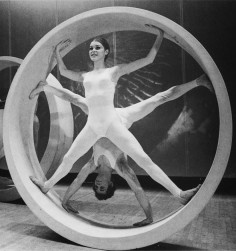Doris Chase
The Old Folks The Opposite Sex Doris Chase Dance Sculptures
source: wmnetworkfr
Doris Totten Chase // Artiste américaine elle fut peintre, architecte, professeur & sculptrice mais Doris Totten Chase (1923-2008) est surtout connue pour être une des pionnières dans la réalisation d’oeuvres maîtresses de Video Art, au côté d’artistes femmes comme Joan Jonas & Martha Rosler.
Dans les années 70 Doris Chase change de vie, de ville et de média ! Elle s’installe dans la Room 722 du Chelsea Hotel cet établissement situé dans Manhattan célèbre dès 1833 pour être la résidence d’artistes de la ville et pour elle commence sa nouvelle vie de vidéaste avec la découverte du travail de l’image sur ordinateur, le traitement de l’image, la synthèse et la colorisation & les effets spéciaux.
Ces toutes 1ères vidéo Circles I & II sont une ode à la rêverie, une utilisation artistique des machines & la réunion de toutes formes d’Art et notamment des danseurs interactifs qui utilisent ses sculptures afin de créer un effet Motion..
.
.
.
.
.
.
.
source: toysandtechniquesblogspot
A sculptor who revolutionized avant-garde dance with kinetic fiberglass playforms for dancing tots? A painter and video artist who used computers borrowed from the Boeing Company to layer visual effects on multimedia happenings scored by Morton Subotnick? A Seattle housewife who ended up in the notorious Chelsea Hotel wearing a welder’s mask working out of her studio kitchen? How had I not heard of Doris Chase before?
Some of Chase’s early video art is now up on youtube courtesy of her gallerist (see below). Absolutely mindbending stuff in the vein of Nam Jun Paik with an enduring fascination with circles and spheres of all colors. Total rainbow pixel heaven. In the late sixties she built large kinetic structures for a light-show-enhanced kid’s performance at the Seattle Opera! And I believe I have actually seen her public sculpture in Kerry Park in Seattle. What an amazing person and artist!
(images via Patricia Failing’s fantastic book, Doris Chase: Artist in Motion.)
.
.
.
.
.
.
.
source: washingtonedu
Doris Chase has achieved international stature as a pioneer in the field of video art since she moved from Seattle to New York City in 1972. An artist of remarkable and continuous creativity, Chase now divides her time between her video headquarters in New York and a Seattle studio where she works on new projects in painting and sculpture.
Beginning as an innovative painter and sculptor in Seattle in the 1950s, Chase created sculpture that was meant to be touched and manipulated by the viewer. Chase then developed large-scale kinetic sculptures in collaboration with choreographers, and her art was set in motion by dancers. In New York, her majors contribution to the evolution of artists’ video has been her work in videodance. On videotape, dancers and sculpture evolve into luminous abstract forms which represent some of the most sophisticated employments of video technology by an artist of the 1970s. In the 1980s, Chase began working in the nascent genre of video theater. In these productions, she uses the imtimacy of the video screen to achieve a new synthesis of visual and dramatic art. Her video theatre compositions present multicultural and social commentary, utilizing scripts by writers such as Lee Breuer, Thulani Davis, and Jessica Hagedorn in the “Concepts” series. Collaborating with actresses Geralding Page, Ann Jackson, Roberta Wallach, Joan Plowright, and Luise Riner in the “By Herself” series, she focuses on the viewpoints and experiences of older women. Today, coming full circle, Doris Chase in Seattle is exploring a renewed interest in painting and sculpture as well as in the modernist aesthetic she never really ceased pursuing, even during her most adventuresome multimedia years.
.
.
.
.
.
.
.
source: finslab
Doris Totten foi uma pintora, professora e escultora, mas é mais lembrada por seu pioneirismo na produção de obras importantes na história da videoarte. Ela era um membro da Escola Noroeste. Nos primeiros anos de sua carreira, o preconceito de gênero estava vivo e bem entre o estabelecimento da arte Northwest, que tendia a tratá-la como uma dona de casa com pretensões. Doris teve uma carreira substancial como uma pintora e escultora antes dela partir para Nova York, onde ela fez vídeos inovadores. Prosseguindo a sua arte era mais fácil do que em Nova York, no Noroeste, onde ela sofreu condescendência considerável por ser do sexo feminino. Sua arte posterior, que muitas vezes defendeu a causa das mulheres, é uma indicação da dor que esse prejuízo causou.


